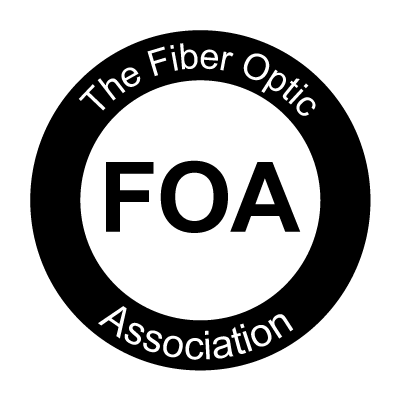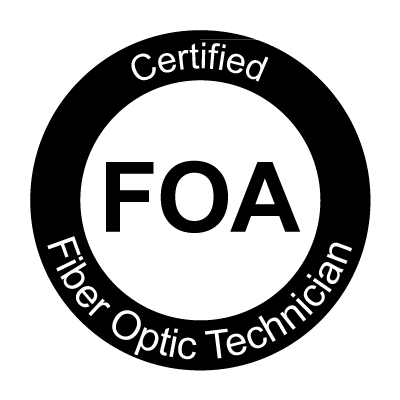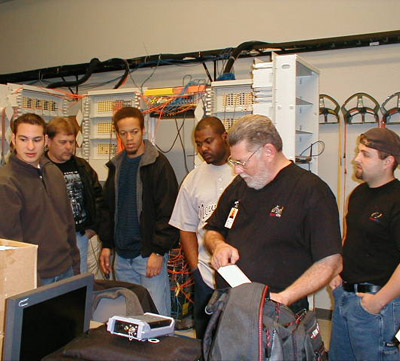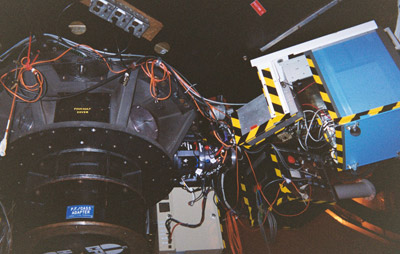Hands On Fiber Optics, Construction, Splicing and Testing
-
Lesson 1: Fiber Optics, The Basics
This section covers the theory of fiber optics, attenuation profiles, electromagnetic spectrum positioning, refraction, reflection, transmission, attenuation, etc.
-
Lesson 2: The Components used in Fiber Optics
This section defines and explains all components used in fiber optic systems, such as cabling, connectors, patch panels, lasers, detectors, splitters, attenuators, etc.
-
Lesson 3: Fiber Optics Network Design
This section describes the various architectures used in fiber optic systems, such as rings or point-to-point. It also discusses the engineering behind link loss estimation and budgets, the relationship between transmitter output and receiver sensitivity, and what it takes to guarantee utilization.
-
Lesson 4: Fiber Optic Connectorizing and Splicing
This section covers the alternatives to terminating fiber cable, and how a network is actually constructed. Extensive hands-on workshops are provided to instruct students on connectorizing, as well as mechanical and fusion splicing.
-
Lesson 5: Fiber Optic Testing and Troubleshooting
This section explains the means of testing fiber optic networks using a variety of test tools, such as light sources, power meters, optical time domain reflectometers (OTDR), as well as accessories that are useful in troubleshooting such as fiber optic talk sets.
-
Lesson 6: Building Codes & Regulations, Installation Considerations and Practices
This section describes the various NEC, UL, and other industry standard codes and regulations regarding the installation of fiber optic cabling and networks. It also provides insight into installation practices for fiber optic cables and networks.
-
Lesson 7: Reference Information and Important Data
This is a section of key data, conversion tables, and other data gathered over the years from field work and accumulated experience.



Advanced Fiber Optic Topics
-
Lesson 1: Background
This section builds reasoning and purpose for the advanced use of fiber optics for local area, metropolitan, and wide area networks, as well as fiber to the home networks.
-
Lesson 2: Advanced Fiber Optic Network Components
This section describes the components used in advanced systems, including WDM’s, DWDM, CWDM, circulators, fiber Bragg gratings, and amplifiers. It also characterizes networks using these components.
-
Lesson 3: Local Area Network Fiber Issues
This section covers multimode fiber effects and limitations on local area transmission using multimode fiber.
-
Lesson 4: Metropolitan and Long-Haul Fiber Issues
This section defines single mode fiber and newly developed fiber characteristics that are needed to transport the various high speed, 10Gbps plus, signals.
-
Lesson 5: Fiber to the Home (FTTH) Discussion
This section describes passive optical networks (PONS) as applicable to fiber to the home deployments. It further covers the various network elements used in modern FTTH systems.
-
Lesson 6: Advanced OTDR Troubleshooting
This section explains tricks of the trade regarding OTDR such as zero dead zone OTDR’s, and long-term averaging to improve the ability for a basic OTDR to produce results in long runs of fiber optic cables, bidirectional analysis, the use of the 1625 nm wavelength for troubleshooting, etc.
-
Lesson 7: Advanced Testing Techniques and Troubleshooting, FTTH Testing
This section discusses the techniques used in troubleshooting splitter networks, time division multiplexed and multiple wavelength networks. It also covers testing of PMD, chromatic dispersion (CD), and the use of optical spectrum analyzers (OSA) in troubleshooting DWDM and CWDM systems. Further, it explains the need for other equipment in troubleshooting such as bit error rate testers, protocol analyzers, and remote monitoring systems.

